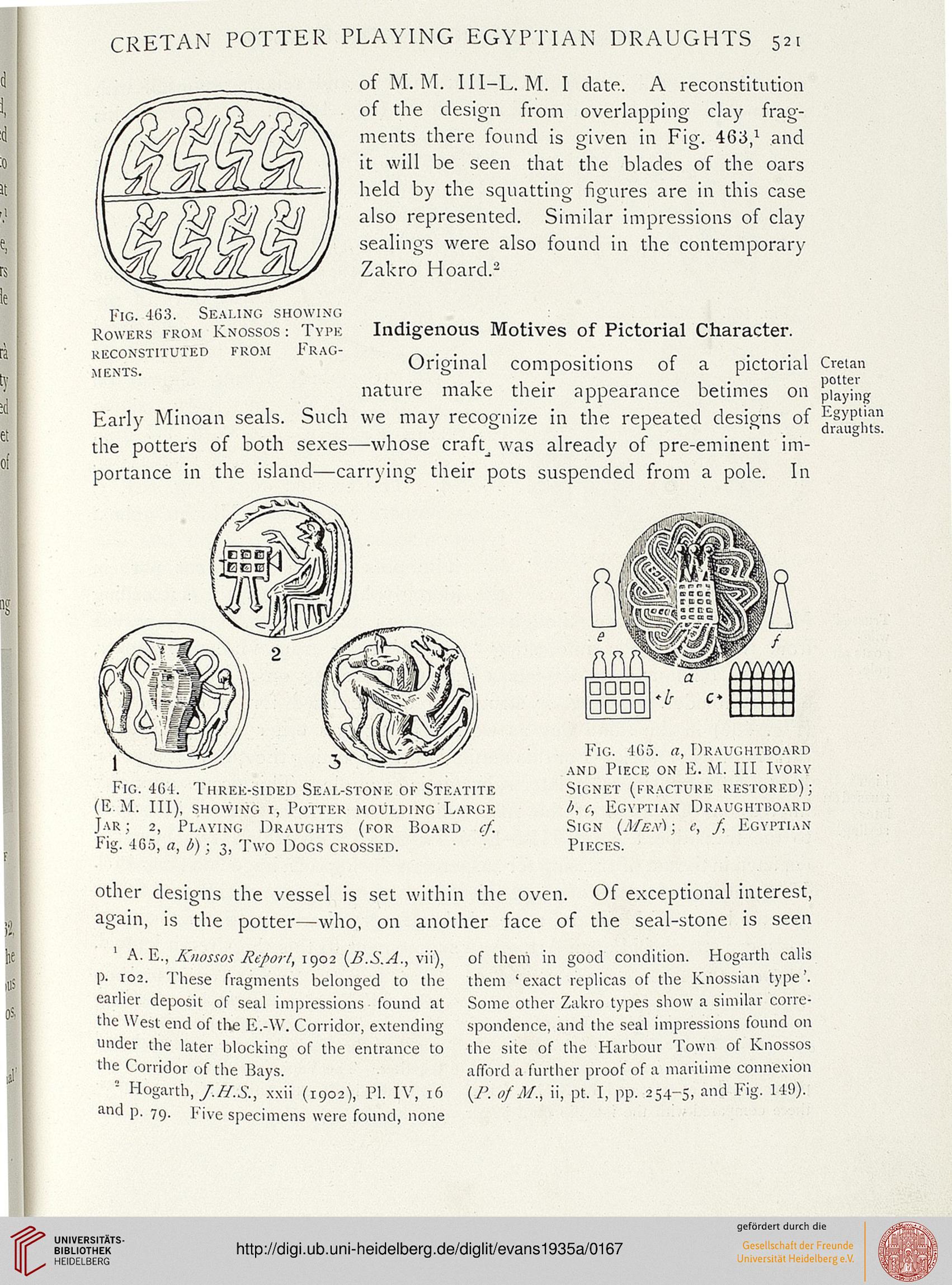CRETAN POTTER PLAYING EGYPTIAN DRAUGHTS 521
of M. M. III-L. M. I date. A reconstitution
of the design from overlapping clay frag-
ments there found is given in Fig. 463,1 and
it will be seen that the blades of the oars
held by the squatting figures are in this case
also represented. Similar impressions of clay
sealings were also found in the contemporary
Zakro Hoard.2
Indigenous Motives of Pictorial Character.
Original compositions of a pictorial Cretan
nature make their appearance betimes on p°aylng
Early Minoan seals. Such we may recosniize in the repeated designs of Egyptian
J J ° 1 " draughts.
the potters of both sexes—whose crafty was already of pre-eminent im-
portance in the island—carrying- their pots suspended from a pole. In
Fig. 463. Sealing showing
Rowers from Knossos : Type
reconstituted from frag-
MENTS.
(\(\(\./-*y»7yv'vy
□ ODD "
□□□a
Fig. 464. Three-sided Seal-stone of Steatite
(E-.1t: III), showing i, Potter moulding Large
.Tar; 2, Playing Draughts (for Board cf.
Fig. 465, a, b) : 3, Two Dogs crossed.
Fig. 465. a, Draughtboard
and Piece on E. M. Ill Ivory
SlGNET (FRACTURE RESTORED) ;
l>, c, Egyptian Draughtboard
Sign (Men); e, /, Egyptian
Pieces.
other designs the vessel is set within the oven. Of exceptional interest,
again, is the potter—who, on another face of the seal-stone is seen
A. E., Knossos Report, 1902 (B.S.A., vii),
p. 102. These fragments belonged to the
earlier deposit of seal impressions found at
the West end of the E.-W. Corridor, extending
under the later blocking of the entrance to
the Corridor of the Bays.
* Hogarth, /.ff:S., xxii (1902), PL IV, 16
and p. 79. Five specimens were found, none
of them in good condition. Hogarth calls
them ' exact replicas of the Khossian type;.
Some other Zakro types show a similar corre-
spondence, and the seal impressions found on
the site of the Harbour Town of Knossos
afford a further proof of a maritime connexion
(/'. ofM., ii, pt. I, pp. 254-5, ™d Fig. 149).
of M. M. III-L. M. I date. A reconstitution
of the design from overlapping clay frag-
ments there found is given in Fig. 463,1 and
it will be seen that the blades of the oars
held by the squatting figures are in this case
also represented. Similar impressions of clay
sealings were also found in the contemporary
Zakro Hoard.2
Indigenous Motives of Pictorial Character.
Original compositions of a pictorial Cretan
nature make their appearance betimes on p°aylng
Early Minoan seals. Such we may recosniize in the repeated designs of Egyptian
J J ° 1 " draughts.
the potters of both sexes—whose crafty was already of pre-eminent im-
portance in the island—carrying- their pots suspended from a pole. In
Fig. 463. Sealing showing
Rowers from Knossos : Type
reconstituted from frag-
MENTS.
(\(\(\./-*y»7yv'vy
□ ODD "
□□□a
Fig. 464. Three-sided Seal-stone of Steatite
(E-.1t: III), showing i, Potter moulding Large
.Tar; 2, Playing Draughts (for Board cf.
Fig. 465, a, b) : 3, Two Dogs crossed.
Fig. 465. a, Draughtboard
and Piece on E. M. Ill Ivory
SlGNET (FRACTURE RESTORED) ;
l>, c, Egyptian Draughtboard
Sign (Men); e, /, Egyptian
Pieces.
other designs the vessel is set within the oven. Of exceptional interest,
again, is the potter—who, on another face of the seal-stone is seen
A. E., Knossos Report, 1902 (B.S.A., vii),
p. 102. These fragments belonged to the
earlier deposit of seal impressions found at
the West end of the E.-W. Corridor, extending
under the later blocking of the entrance to
the Corridor of the Bays.
* Hogarth, /.ff:S., xxii (1902), PL IV, 16
and p. 79. Five specimens were found, none
of them in good condition. Hogarth calls
them ' exact replicas of the Khossian type;.
Some other Zakro types show a similar corre-
spondence, and the seal impressions found on
the site of the Harbour Town of Knossos
afford a further proof of a maritime connexion
(/'. ofM., ii, pt. I, pp. 254-5, ™d Fig. 149).





